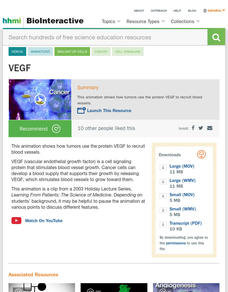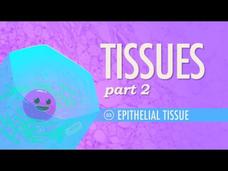Professor Dave Explains
Introduction to Immunology
As we know from our understanding of microbiology, pathogens are everywhere. So why don't we get sick all the time? And what are allergies, why do some people have them and others don't? And what are vaccines, how do those work? All of...
FuseSchool
Plasma
What colour is the liquid flowing through your veins, arteries and capillaries? it’s not blue or red. But technically it’s actually yellow.The blood that you see when you cut yourself looks red because it contains millions of red blood...
Science360
Organs on a chip
For more information from the Khademhosseini lab visit: http://www.tissueeng.net/lab/ Organs on a chip systems could transform the medical drug pipeline as we know it. Biomedical engineer Ali Khademhosseini explains how he and his team...
Mazz Media
Skeletal System (An Overview)
In this live-action program viewers will learn that the skeletal system is the framework of the body. It gives the body shape and provides scaffolding for the body's muscles and organs. Students will come to understand that the skeletal...
Visual Learning Systems
Moving Muscles and Bones: Body Organization
Upon viewing the Moving Muscles and Bones video series, students will be able to do the following: Differentiate between cells, tissues, organs, and organ systems. Provide examples of organs and organ systems in the body. Understand that...
Professor Dave Explains
Types of Plant Cells
If we want to learn about plant structure and function, we have to start with the smallest components, and those would be plant cells. Just like animals, plants are made of eukaryotic cells of different types, and in plants these are...
Ancient Lights Media
Cells - Overview & Introduction
Cell Structure and Function Set: 1. This clip introduces the cell as the basic block of life: Basic cell structure in prokaryotes and eukaryotes is described.
Curated Video
A California''s dairy producer has become the focus of intense scrutiny now that mad cow disease has been discovered in a dead cow. Still, an unrelated cattle producer in Illinois says the USDA system works well so there''s nothing to worry about. (
HEADLINE: Ill. cattle producer dismisses mad cow concerns
CAPTION: A California''s dairy producer has become the focus of intense scrutiny now that mad cow disease has been discovered in a dead cow. Still, an unrelated cattle producer in...
Curated Video
First human recipient of laboratory-grown bladder
AP Television
Haddam, Connecticut, 31 March 2006
1. Kaitlyne McNamara, bladder transplant patient walking with family
2. Close up of Kaitlyne
3. Kaitlyne walking towards her house
4. Kaitlyne with leg braces walking up steps
5. Set up...
Curated Video
Harvard's Dr William Kaelin Jr discusses Nobel win
A Massachusetts researcher says he had " an out-of-body type of experience" when he got a predawn call informing him that he was one of three scientist won the 2019 Nobel Prize for Physiology or Medicine.
Bridgeman Arts
A young lady gets shown the histology department of a hospital laboratory, 1954
Part 4 of an educational film about a career in Medical Technologist, Canada 1954. A young lady gets shown the histology department of a hospital laboratory. (acted).
TED-Ed
What Is Leukemia?
Leukemia afflicts children more than any other type of cancer. Pupils explore the nature of harmful mutations in cell DNA, the reproduction of damaged cells in blood and bone marrow, and their effect on normal functions of the human...
TED-Ed
How to 3D Print Human Tissue
Could a 3-D printer be the answer to the shortage of organ donors? A quick video lesson describes how the printers can print human tissue. A set of online questions challenges learners to review the information in the lesson and reflect...
TED-Ed
The Mysterious Science of Pain
The amount of pain one experiences is not directly connected to the amount of tissue damage. In fact, it is possible for pain to occur without any tissue damage at all! A video lesson digs into the science behind the phenomenon and asks...
Howard Hughes Medical Institute
VEGF
Have you ever wondered what causes tumors to grow? VEGF is a very important factor because it is a hormone that causes blood vessels to grow and is triggered by cancer cells to increase blood supply to a tumor. Viewers learn about the...
Amoeba Sisters
How Cells Become Specialized
Cell specialization is amazing! How do they know what they should become? A video from an interesting biology playlist examines the process of cell specialization. Content includes where we find specialized cells, types of specialized...
Crash Course
Tissues – Epithelial Tissue (Part 2)
Epithelial tissues plays a variety of roles in the human body, including covering, lining, making a barrier, protection, excretion, filtration, absorption, and sensation. The video teaches high schoolers about epithelial tissue and its...
Crash Course
Tissues (Part 1)
Once a nerve cell is damaged, it cannot be reproduced. Video number two in a series of 47 introduces high schoolers to tissues, focusing on the four types: nervous, muscle, epithelial, and connective. The narrator teaches their...
Bozeman Science
Hierarchy of Life
The leader of the biology gang is known as the nucleus. In the video, learners see the different levels of the hierarchy of life. Scholars explore each level, listening to descriptions and seeing examples of each one. It is the second...
Bozeman Science
Homeostasis Hugs
Penguins, seals, and whales have countercurrent heat exchangers to limit blood flow in certain areas of their body, limiting their rate of heat loss to their environment. In this homeostasis video, the instructor explains that...
Bozeman Science
Plant Structure
Let's get to the root of biology. A video describes the difference between monocot and dicot plants. Then it explains the three main types of tissues in plants and the cells within each of these tissues.
Crash Course
Comparative Anatomy: What Makes Us Animals
What makes animals, well, animals? Viewers of a via comparative anatomy video see how similarities and differences in animal anatomy help support the theory of evolution. The video also includes examples of shared characteristics in...
Bozeman Science
Cellular Specialization
Embryonic stems cells were only first discovered in 1998 — less than 20 years ago. The video explains what stem cells are (both pluripotent and totipotent), how they become specific types of tissues cells via internal cues such as the...












